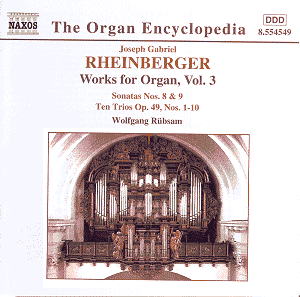Joseph Gabriel RHEINBERGER
(1839-1901)
Works for Organ, vol. 3
Organ Sonata 8 in E minor Op 132 [26.31]
Organ Sonata 9 in B fat minor, Op 142 [28.19]
Ten Trios Op 49 [18.47]
 Wolfgang Rübsaum
Wolfgang Rübsaum
Organ of Fulda Cathedral
rec. Fulda Cathedral, Germany, 15. 2. 99/27. 6. 99
 Naxos 8.554549
[73.38]
Naxos 8.554549
[73.38]
Crotchet AmazonUK
AmazonUS

Listed Comparison
Ten Trios Op 49
Rudolf Innig, the Walcker Organ St Maria, Schramberg (rec. 6-8. 1. 99, on
location) Dabringhaus und Grimm, MDG 317 0892-2
Whereas as in their Dupré cycle Naxos have arrayed several organs
and organists against the lone Jeremy Filsell on Guild, the two Rheinberger
cycles pit it out: organist and organ vs organ and organist. Wolfgang
Rübsaum, at the Organ of Fulda Cathedral reaches his third CD in a swifter
traversal of all the Organ Sonatas. For Dabringhaus und Grimm, Rudolf Innig
plays the Walker Organ St Maria, Schramberg. Honours are about even - though
reviewers tended to favour the Naxos cycle, with its fine recording and more
attractive flow of tempi. Mostly, it seems Rübsaum's organ is preferred.
Rübsaum is consistently slower than Innig. The latter in his first volume
played a great deal of juvenilia and the whole cycle promises to be more
comprehensive. Naxos perhaps have woken up to this and have started adding
music other than the Sonatas to their disc - perhaps simply avoiding the
juvenilia. But who really would have credited two rival ongoing cycles of
Rheinberger a few years ago? I'm not sure CPO's Wolfgang Stockmeier ever
made the full traversal in the late 1980s. We're very fortunate.
And so we reach 1882, nearing midway through the cycle and Rheinberger's
career - a much steadier development than say Widor's whose Symphonies were
mostly early. The Eighth Sonata in E minor, marks a real advance on the preceding
works, fine as they are. The Praeludium is an empathic tolling affair
that swings its minor-keyed angst straight into a lasagne-layered fugue,
and after working it out into E major. The surprisingly quiet
Intermezzo, is followed by a Scherzoso of fire and A minor,
and a powerful, muted Passacaglia. This has at its heart a kind of
singing lament, a remarkably tuneful nostalgic requiescat feel to it. It
builds up in 24 variations with a true sense of the form, as one would expect
with this arch pedagogue.
The 10 Trios Op. 49 are much earlier, 5-8 October 1868 (so D&G, not Keith
Anderson, informs me for once). As Anderson says there's much attractiveness
in the first piece in G minor, which Innig takes with more drama and agogic
hesitation and seems here more closely miked. Perhaps the Trios need such
scrutiny, but Rübsaum allows them to flow smoothly enough. They provide
practice in trio playing, and are a little Beidermeirish.
The 9th Sonata in B flat minor of 1885 provides another monolithic contrast.
And no wonder. It was written for Alexandre Guilmant (1837-1911) that great
predecessor of Widor and another writer of (eight) Sonatas. The first movement
is cast in a Praeludium and Fugue, with a slow introduction. This
is less doom-laden and more heroic in tone than the 8th Sonata, reflecting
perhaps the public tone of the great fellow-organist to whom it was dedicated
and written for. It swiftly moves into an allegro moderato which plateaus
very attractively into returns of theme and ultimately a return of the slow
introduction. The gentle E major Romance as Anderson calls it, is
most winning, poised as it is between the monumental forms like a wild flower
between two menhirs at Aylesbury. The final Fantasia veers between
allegro moderato and Adagio, and eventually settles into a
B flat major Fugue. This develops by involving themes from the opening and
other reminiscences, bringing this quite wide-ranging work to a satisfying
tight conclusion. There's a touch of the portentous about the
Guilmant/Rheinberger relationship. On the strength of this there is a mutual
admiration; but based on their corresponding genius for the organ, hardly
anything to find amiss. Their shared delight in such writing emerges here
in a delight in the organ and its forms for its own sake. They pay homage
to their own vanished world. It might appear a little upholstered but its
values and delights were solid, and on this evidence, enduring. Rübsaum
plays with a shared delight.
Clearly Rübsaum at this price is unmissable, and his traversal through
the Sonatas is a slimmer affair than the massive D und G project. But because
of the extras, the latter might be worth investing in. It's superbly recorded
too, and even more luxurious. This company tend to release complete organ
sets like Reger and Buxehude at knock-down prices which might be worth waiting
for. But Innig too, is a player one might patronise before the company loses
heart! Meanwhile, don't hesitate to acquire Rübsaum's glowing account
on this very Rheinbergerish organ.
Simon Jenner

